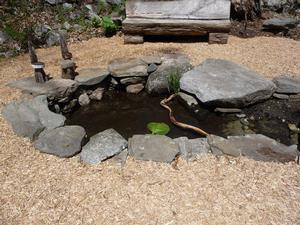The Treasure that is Palmer Arboretum
The Palmer Arboretum is a local treasure tucked out of sight behind the Palmer Memorial building in Woodstock. The arboretum was founded by Minnie Palmer Dean, a generous philanthropist, in 1914-15. Minnie busied herself with the arboretum and Palmer Memorial Hall, built as a small, exquisite concert hall. Minnie left both to Woodstock in her 1925 will. To this day Woodstock retains ownership.
Memorial Hall became Town Hall for 50 years. The arboretum was abandoned, all but forgotten. Rediscovered by Margot Cassedy, Arthur Manthorne, Ruth Kimball and Mary Seney during the bicentennial in the late1970s its recovery began. The park had reverted to woodland becoming so over-grown trails had to be blazed. The original plant list was found in town hall records. Many of the nearly century-old specimens were identified and salvaged. These include a Sawara Cypress grove (Chamaecyparis pisifera), a majestic specimen European Beech, and a large Ginkgo biloba.
A formal arboretum committee was formed in 1985. With its formation refurbishment has continued steadily. Three acres had been broken off from the original five-acre plot and sold many decades ago. Though presently a two acre park it is, nonetheless, rich and beautiful, beginning where the parking lot ends behind the Palmer Memorial Building.
Much of the arboretum is couched in dappled, part and open shade providing cool cover in summer, more light in winter and spring plus the bonus of beautiful autumn color when leaves raise their voices in windy choruses before whirling, dancing to the ground below. Gently curving broad paths graciously descend through this peaceful place complete with seating areas alive with birds and rich plantings.
Two entrances are the park's doorways. The Rain Garden is the first feature one will find at the edge of the parking lot. Many native and near native species are set in handsome arrangement including Inkberry, Winterberry, Sweet Pepperbush, Blue flag Iris, Joe-pye Weed, Purple Cone Flower, and St. Johnswort. The appealing design masks utility as a "smart sponge". Jean Pillo from the State Dept. of Energy and Environment Protection paved the way for EPA grant money to install the Rain Garden.
Just a short walk beyond the Rain Garden entrance is a shady glen with border gardens, one newly planted this past spring. These encompass and balance an island garden complete with mature woodies, hosta and barrenwort. On the left just beyond the island is a specimen Ginkgo biloba. Strolling farther down the broad, grassy pathway and veering left under the impressive Sawara Cypress grove a shady garden designed by Linda Kaplan as her master gardener project now grows. Up to sixty-six different herbaceous species have been included which provide interest from spring into autumn. Across the way is the arboretum's statuesque specimen European Beech. A beautiful hedge of Fothergilla erupts with scented white bottle brush flowers in spring metamorphosing into a riotous mix of autumn color.
A field stone viewing terrace is paired with the North entrance. This Ben Gormley Eagle Scout project contains a seating area where one can relax and overview the near entirety of the park into the dappled shade where wetlands convene at the basin. Here can be found Tree Lilac, ornamental sedges, Barrenwort and native ferns.
Matt Sheldon and his family cleared the wetland area of the arboretum of exotics which clotted admittance. They installed two beautiful rustic wooden bridges, one 60 feet long over the stream outlets These stretch over wetlands providing passage to drier landings. Now that the infrastructure of bridges, benches and the design underscoring the beauty of the natural spring, the wetlands basin is the board's next project.
Many other plants reside at Palmer. Viburnum, Yellowwood, fragrant Azaleas, Stewartia pseudocamellia, Paperbark Maple and Japanese Maples are but some of the highlights. A spectacular grove of Devil's Club is the foil for a small house-shaped structure that suggests a scene from a childhood fairy tale.
Volunteers are an integral component in reclaiming this laudable landmark. These interested parties include Hyde School, Pomfret School and Compassion Camp, a combined youth group from Woodstock's First Congregational and East Woodstock Congregational Churches. Arborists lending a hand are Dennis Panu and Chad Hart, Linden Tree and Jonathan Roy's Tree Services. Hull Forest Products has donated many yards of wood chip mulch. Students of Professor Kristen Schwab, UConn Landscape Architecture, provided designs which are still being implemented as upgrades proceed. As more people come to recognize Palmer's intrinsic value more folks have donated products, time and services.
This gem is worthy. It's a pleasant and serene walk sporting a diverse wealth of trees, shrubs and perennials beautifully placed in pleasant, naturalistic designs which intelligently accentuate the lay of the land. Perfect for a quiet, reflective stroll, pack a light lunch and enjoy the scenery in any season. The park is open every day from dawn to dusk.
penned by Wayne Paquette, September 2014, published in Villager Newspapers in July, 2015
